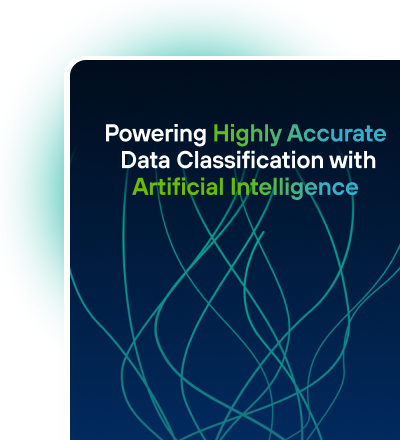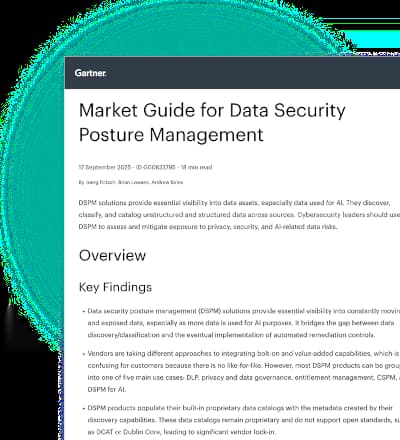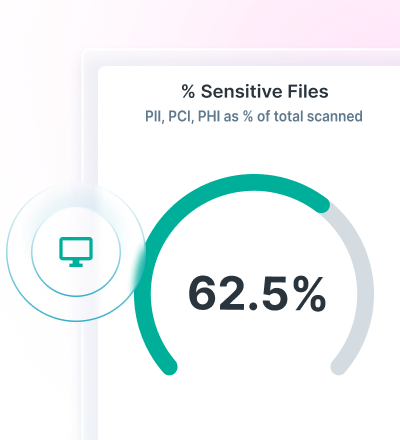
Más de 12.000 clientes no podían equivocarse










































Obtenga visibilidad y control sobre los datos confidenciales
Arroje una luz a los datos oscuros con una detección amplia de datos y una clasificación de alta precisión.
El software de Forcepoint DSPM escanea cualquier fuente de datos y utiliza tecnología de malla de IA patentada para identificar, categorizar y remediar datos de alto riesgo.
Es una solución perfecta si sus equipos de seguridad luchan con:
Grandes cantidades de datos ocultos
Datos con permisos excesivos
Riesgos de filtración de información de la IA generativa
Ubicaciones de datos no identificados
Forcepoint DSPM Software Leads the Pack
Forcepoint is the only Data Security Posture Management vendor that uses AI Mesh technology to deliver highly accurate data classification. Read the full comparison chart to learn why organizations trust the leading data security provider to discover and catalogue data and remediate risk at scale.
20%
40%
60%
80%
100%
Forcepoint
Traditional Vendor
Data Governance Vendor
Por qué Forcepoint DSPM es una herramienta de seguridad de primer nivel
Mejore la Visibilidad de los Datos
Obtenga una visibilidad completa de los datos estructurados y no estructurados en la nube y on-premises para realizar un seguimiento y administrar los datos confidenciales donde sea que residan.
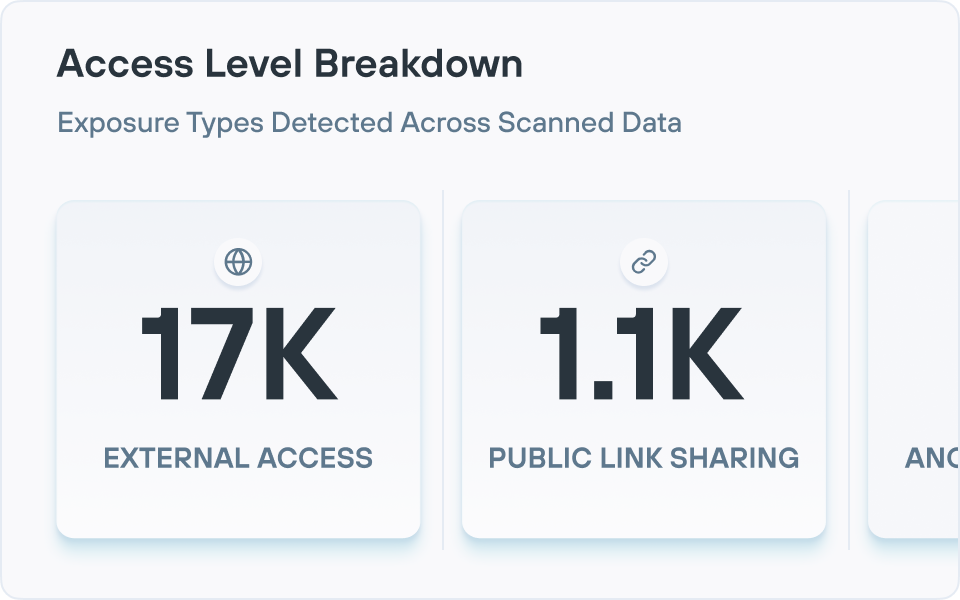
Detecte y clasifique con IA
Utilice la tecnología de AI Mesh de alta precisión para una detección y clasificación de datos eficientes y confiables, reduciendo los falsos positivos y mejorando la precisión de las alertas de incidentes
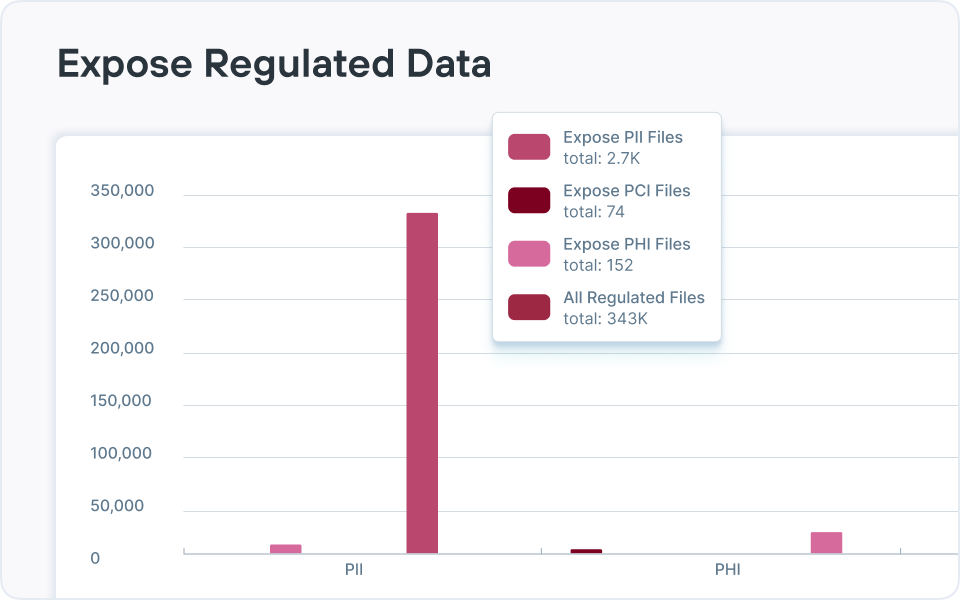
Corrija los riesgos de manera proactiva
La información valiosa le permite administrar permisos, mover datos mal ubicados y abordar problemas de soberanía de los datos, acceso y duplicación o datos ROT.
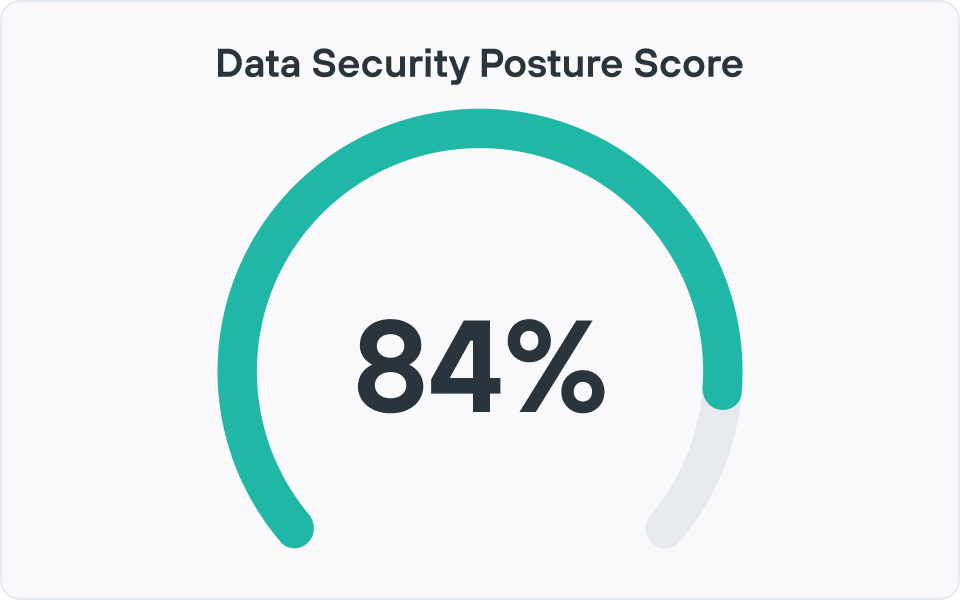
Automatice la administración del cumplimiento
Simplifique los procesos de cumplimiento con la automatización para garantizar una alineación consistente y continua con las regulaciones en evolución, reduciendo el esfuerzo manual.
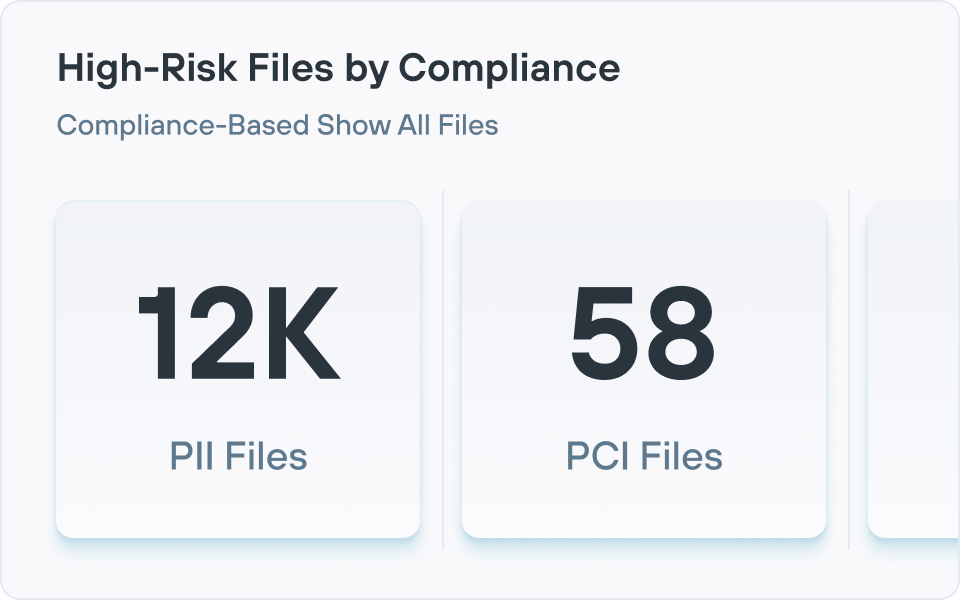


Identifique la precisión y la transparencia de los informes
Enda Kyne, CTOO de FBD Insurance, dice que DSPM y DDR han sido adoptados por sus equipos de seguridad de TI y protección de datos por su capacidad para controlar datos críticos e informar actividades a los reguladores.
Strengthen Your Data Security Posture


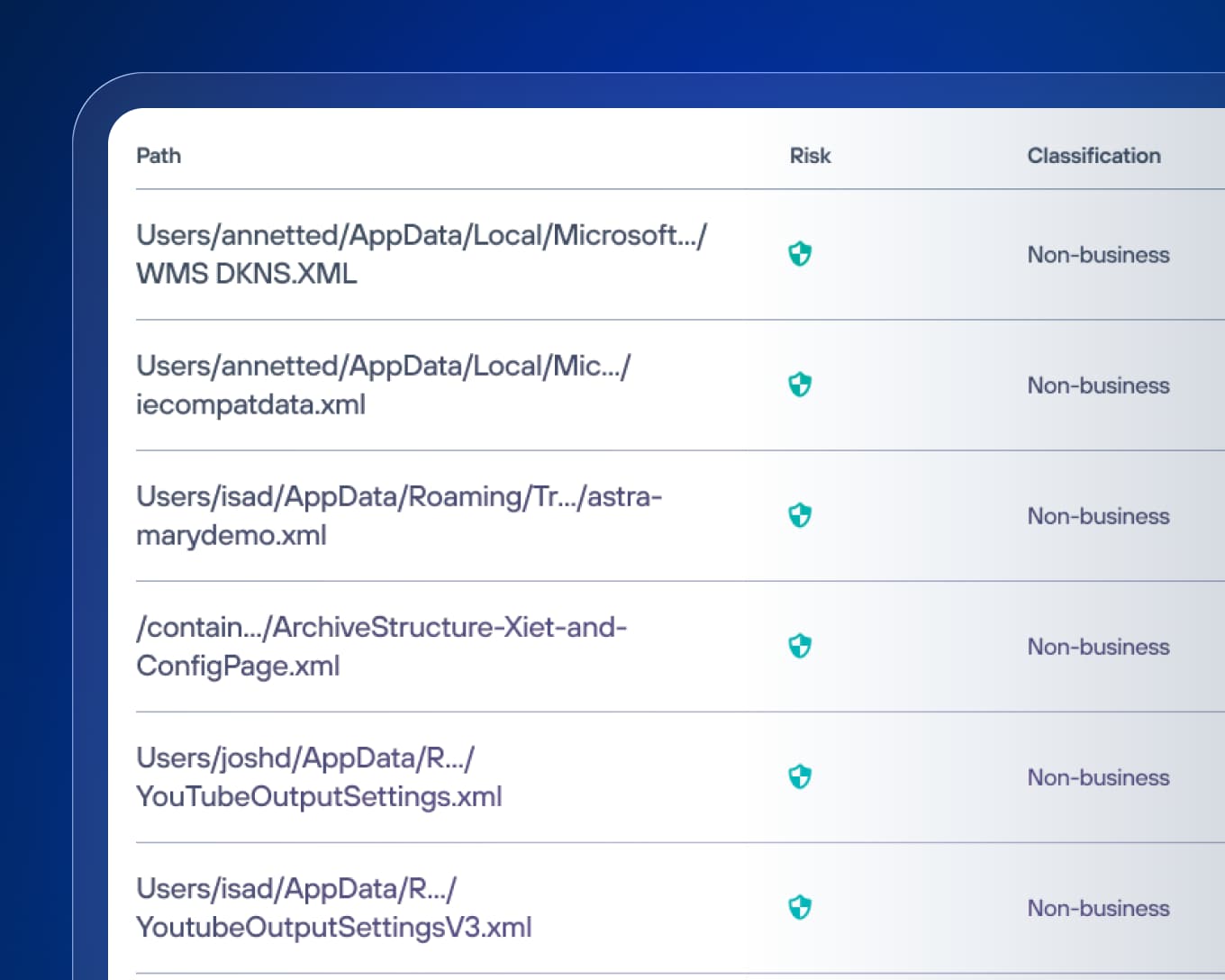

Rapidly and precisely identify sensitive data-at-rest with self-improving AI Mesh technology paired with proven DLP classifier policies for maximum efficiency.

Extend visibility and control over all your regulated data, eliminate gaps and generate automated reports to demonstrate compliance.

Gain a centralized view of your data and enforce the Principle of Least Privilege across cloud, SaaS and on-prem systems for effective governance.


¿Están sus datos en riesgo?
Data Risk Assessment descubre proactivamente las amenazas para sus datos, ya sean archivos confidenciales no clasificados o usuarios con permisos excesivos. Solicite un Data Risk Assessment gratuita con Forcepoint para ver DSPM en acción y conozca qué tan seguros están sus datos.

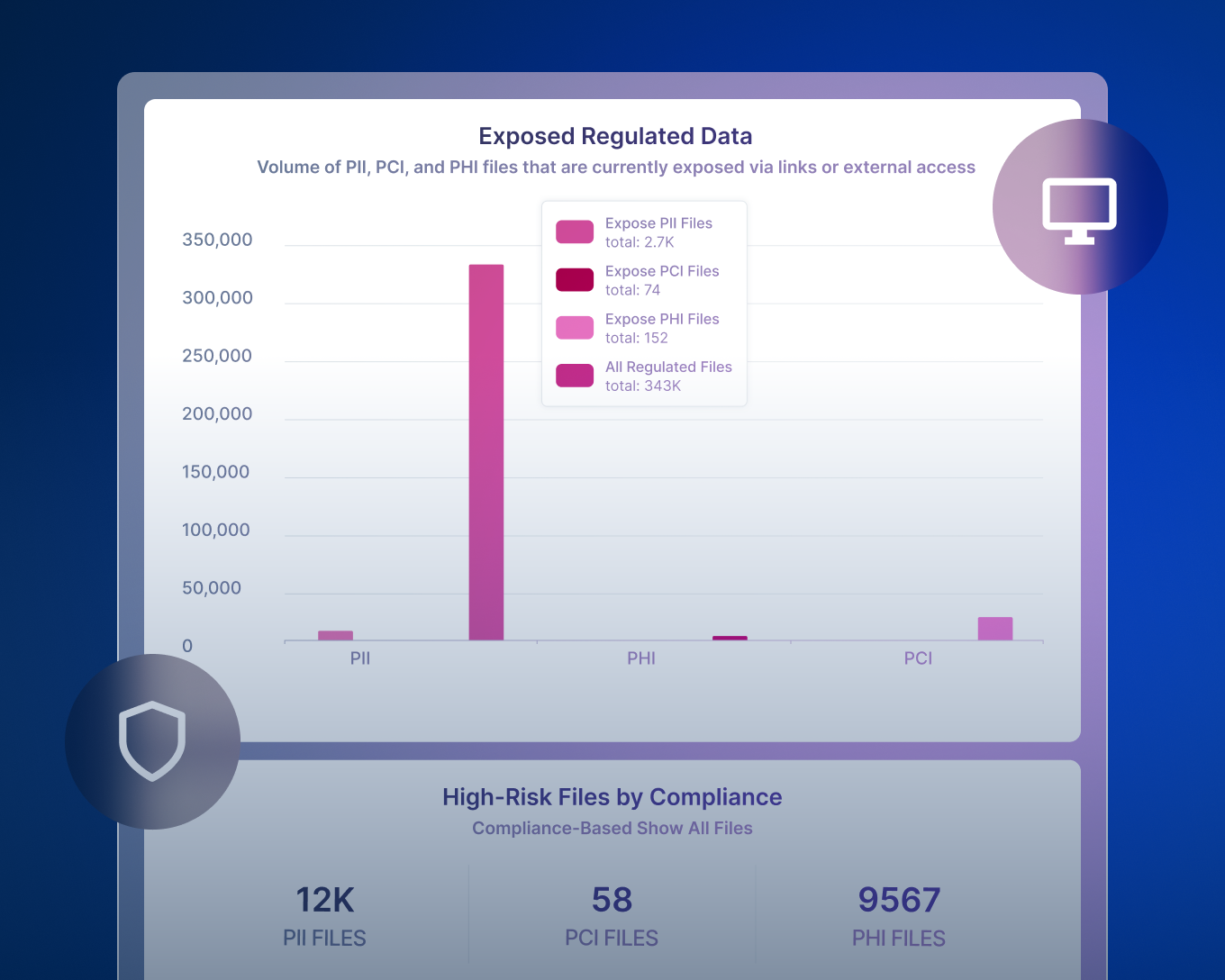


Capacidad para integrar DLP, DSPM y DDR para el descubrimiento, la clasificación, la protección y la remediación de los datos.

Proporciona informes de riesgos eficaces, que le permiten ver datos de ROT (redundantes, obsoletos, triviales), datos con permisos excesivos, problemas de soberanía de los datos y muchos otros que hacen que la postura general de los datos sea riesgosa.

Ofrece visibilidad y control sobre la preparación de los datos para todas las aplicaciones de GenAI. También es capaz de proteger el uso de Copilot y ChatGPT Enterprise.
Historias de nuestros clientes
Historias de nuestros clientes
"As part of Forcepoint’s broader data security ecosystem, DSPM has integrated seamlessly with our existing solutions. It’s an essential component of our overall data security strategy."
Indonesia Financial Group (IFG)
Recomendado por analistas.
Aprobado por usuarios.
Forcepoint está clasificado constantemente entre los mejores proveedores de software de prevención contra la pérdida de datos y de software de seguridad de datos por usuarios y analistas de la industria.
Forcepoint fue nombrada Líder en IDC MarketScape: Worldwide DLP 2025 Vendor Assessment.
Forcepoint fue nombrada la Compañía Global de DLP del Año 2024 por segundo año consecutivo por Frost & Sullivan.
Forcepoint fue reconocida como una Strong Performer en The Forrester Wave™: Data Security Platforms, T1 de 2025.
Implemente las mejores prácticas de Data Security Posture Management
Preguntas frecuentes
¿Qué es Data Security Posture Management (DSPM)?
Data Security Posture Management es una solución de seguridad que descubre continuamente dónde residen los datos confidenciales, cómo se clasifican y quién puede acceder a ellos en la nube, SaaS y entornos on-prem.
El DSPM nativo de IA de Forcepoint sigue este mismo modelo: Inventoria continuamente los datos estructurados y no estructurados, utiliza la tecnología de AI Mesh para clasificar con precisión los datos en el almacenamiento de archivos, aplicaciones en la nube y ubicaciones on-prem, y evalúa si alguno de esos datos está en riesgo a través de una variedad de lentes.
Forcepoint DSPM ayuda a aumentar la productividad, reducir los costos, reducir el riesgo y optimizar el cumplimiento al convertir la postura de una auditoría periódica en una visión en vivo del riesgo de los datos.
¿Cómo funcionan las soluciones de DSPM?
La mayoría de las plataformas de DSPM siguen un ciclo de vida recurrente: descubre los datos (estructurados y no estructurados en múltiples nubes y on-prem), clasifica los datos por sensibilidad y contexto empresarial, evalúa y prioriza los riesgos (como el acceso con privilegios excesivos o los datos mal ubicados), remedia las configuraciones incorrectas o el acceso inseguro, y luego monitorea continuamente para mantener la postura actual.
Forcepoint DSPM implementa esto con AI Mesh, una arquitectura de clasificación de IA que utiliza pequeños modelos de lenguaje y redes neuronales profundas. Forcepoint DSPM escaneará las fuentes de datos integradas, identificará y categorizará los datos de alto riesgo, y recomendará los siguientes pasos para la remediación para que el equipo pueda ajustar los permisos, mover los datos mal ubicados, limpiar los datos redundantes, obsoletos o triviales (ROT) y solucionar los problemas de soberanía en lugar de detenerse en los informes.
Las actualizaciones recientes extienden Forcepoint DSPM más allá de los archivos en bases de datos empresariales y data lakes, por lo que el mismo modelo de detección, clasificación y aplicación adaptativa ahora cubre los datos estructurados y no estructurados en una única plataforma unificada junto con Forcepoint DDR y DLP.
¿Cómo funcionan las capacidades de descubrimiento de datos del software de DSPM?
DSPM descubre continuamente datos en la nube, la red y el almacenamiento on-premises para descubrir y catalogar cada dato que tiene su organización. Encontrar datos confidenciales es el primer paso crucial para protegerlos. Las soluciones de DSPM escanean todo su ecosistema de datos, como:
- Plataformas en la nube (AWS, Azure, GCP)
- Aplicaciones de SaaS (Microsoft 365, Salesforce)
- Almacenamiento y bases de datos on-premises
El software de DSPM moderno mantiene una visibilidad continua a medida que los datos se mueven y cambian a través de funcionalidades incorporadas o integraciones de soluciones.
¿Qué capacidades de clasificación de datos y evaluación de riesgos proporciona una solución de DSPM?
Una solución de DSPM madura ofrece una cadena de capacidades:
- Detección de datos y clasificación impulsada por IA: Escaneo automatizado de la nube, SaaS, endpoints y tiendas on-prem, mediante IA ajustada para clasificar con precisión los datos estructurados y no estructurados por sensibilidad y propósito comercial, con modelos ajustables para reducir los falsos positivos.
- Data Risk Assessment más análisis y priorización de riesgos: Crea un inventario de datos confidenciales, luego califica el riesgo según la exposición, el acceso excesivamente permisivo y el impacto comercial para que los equipos se enfoquen primero en los conjuntos de datos más críticos; Forcepoint utiliza la calificación de riesgos y las estimaciones de impacto financiero para priorizar la mitigación.
- Gobernanza de acceso: revela quién tiene acceso a qué datos, destacando el intercambio público o externo, las cuentas inactivas y las carpetas compartidas de manera excesiva, con una visibilidad profunda de los permisos a través de integraciones de directorios.
- Cumplimiento e informes: genera dashboards, auditoría trails e informes alineados con el marco (para regulaciones como GDPR, LFPDPPP o HIPAA) que mapean los datos regulados, documenta los controles y simplifica las auditorías; Forcepoint añade plantillas de políticas, informes automatizados y clasificación de IA explicable para agilizar la demostración de cumplimiento en entornos híbridos.
¿Cómo ayuda una plataforma de DSPM a las organizaciones a administrar y remediar el riesgo?
Identificar problemas sin resolverlos crea poco valor. Las plataformas modernas de DSPM cierran esta brecha con controles personalizables que se adaptan a las necesidades y desafíos únicos de su organización. Estos controles incluyen la gestión de permisos para implementar el principio de mínimo privilegio (PoLP), garantizando que los usuarios solo accedan a los archivos necesarios para sus tareas y abordando los datos con permisos excesivos o de acceso público.
Las capacidades adicionales incluyen el mapeo de datos para categorizar correctamente la información confidencial, la remediación de datos mal ubicados para abordar archivos almacenados en repositorios inapropiados, y flujos de trabajo de archivado/eliminación de datos para gestionar archivos en riesgo que han pasado los períodos de retención o clasificados como ROT (redundantes, obsoletos, triviales).
¿Cómo funcionan los informes y análisis dentro del software de DSPM?
Las soluciones de DSPM incluyen herramientas de análisis y elaboración de informes que proporcionan visibilidad sobre el estado general de seguridad de datos de una organización.
Estas capacidades de generación de informes generalmente incluyen paneles que muestran dónde existen datos confidenciales en entornos, y destacan factores de riesgo específicos, como datos de ROT (redundantes, obsoletos, triviales), archivos con permisos excesivos, información mal ubicada y contenido duplicado.
Los equipos de seguridad pueden utilizar esta información para realizar un seguimiento de las métricas a lo largo del tiempo y priorizar los esfuerzos de remediación donde tendrán el mayor impacto.
¿Forcepoint DSPM se implementa on-premises o en la nube?
Las soluciones de DSPM ofrecen opciones de implementación flexibles:
- SaaS nativo en la nube para una implementación rápida
- Modelos híbridos para entornos confidenciales
- On-premises para el control sobre la soberanía de los datos
- Arquitecturas sin agente para minimizar los gastos generales
La mayoría de las empresas comienzan con sus repositorios de datos más críticos y expanden la cobertura de manera incremental.
¿Cómo utiliza Forcepoint DSPM la IA y la automatización?
La automatización permite el descubrimiento y el escaneo de datos continuos y a gran escala en entornos empresariales. Las organizaciones ahora pueden clasificar automáticamente los datos en tiempo real a medida que se crean, mueven o modifican, y así eliminar los retrasos y las brechas inherentes a las revisiones manuales.
El valor principal de la inteligencia artificial radica en ofrecer una clasificación de datos de alta precisión, a la vez que reduce los falsos positivos. La IA aporta la precisión necesaria para distinguir con confianza entre datos verdaderamente confidenciales e información benigna que podría activar sistemas tradicionales basados en reglas.
Para que las soluciones de DSPM incorporen estas capacidades con confianza, las soluciones modernas deben manejar una amplia gama de tipos de archivos, desde PDF hasta videos, y también comprender una serie aún más amplia de campos de datos para asignar clasificaciones correctas y realizar ajustes según los requisitos de cumplimiento. Esto incluye el aprovechamiento de las capacidades de IA generativa, clasificadores de redes neuronales profundas y otras tecnologías de IA predictiva que trabajan juntas..
¿Cuáles son los beneficios clave que las organizaciones podrían obtener al implementar una plataforma de DSPM?
Los beneficios de Data Security Posture Management pueden resumirse en cuatro resultados:
- Aumente la productividad productividad Servicios
- Reduzca costos con Servicios
- Reduzca el riesgo
- Optimice el Cumplimiento
¿DSPM se integra con otras tecnologías de seguridad?
DSPM rara vez opera de manera aislada. La mayoría de las organizaciones lo integra con tecnologías de seguridad complementarias para crear una estrategia de protección de datos integral. La información que proporciona el software de DSPM sobre la ubicación de los datos, la confidencialidad y el riesgo naturalmente mejora otras herramientas de seguridad, como:
- Data Detection and Response (DDR)
- Data Loss Prevention (DLP)
- Cloud Access Security Broker (CASB)
- Identity and Access Management (IAM)
- Cloud Security Posture Management (CSPM)
¿En qué se diferencia DSPM de las herramientas de clasificación de datos heredadas?
A diferencia de las herramientas tradicionales que trabajan con repositorios de datos conocidos que utilizan reglas predefinidas, DSPM descubre continuamente datos conocidos y desconocidos en entornos, y aprovecha la IA para una clasificación más precisa y proporciona contexto sobre los patrones de acceso y los controles de seguridad.
¿Cómo ayuda DSPM a evaluar la postura de seguridad?
Data Security Posture Management (DSPM) evalúa la postura de seguridad mediante la detección continua de dónde se encuentran los datos confidenciales (en la nube, SaaS, on-prem), clasificándolos por sensibilidad y mapeando quién tiene acceso a ellos.
Forcepoint DSPM utiliza su motor de AI Mesh más amplios conectores para inventariar datos estructurados y no estructurados. Destaca los archivos sobreexpuestos, los datos de ROT y los permisos riesgosos, y los correlaciona en un Data Risk Assessment.
Luego proporciona monitoreo y análisis de alto rendimiento para mostrar cuánto de los datos confidenciales están en riesgo, qué ubicaciones y unidades de negocio impulsan la mayor exposición, y cómo los cambios a lo largo del tiempo afectan el riesgo general de los datos. Estos conocimientos salen a la superficie a través de dashboards e informes detallados, que brindan a los equipos de seguridad y cumplimiento una visión actual y medible de su postura de seguridad de datos en lugar de auditorías puntuales.
¿Cuál es la diferencia entre SSPM y CSPM y DSPM?
CSPM (Cloud Security Posture Management) se centra en la infraestructura en la nube: configuraciones, controles de red, identidades y servicios de plataforma. Encuentra y ayuda a corregir las configuraciones incorrectas en entornos de IaaS, PaaS y SaaS, no el contenido de los datos en sí.
SSPM (SaaS Security Posture Management) se centra en las aplicaciones de SaaS: la configuración de seguridad, el acceso y las integraciones en servicios como Microsoft 365, Salesforce y más.
DSPM (Data Security Posture Management) se enfoca específicamente en los datos: detección, clasificación y evaluación del riesgo en torno a la información confidencial dondequiera que se almacene. Responde, "¿qué datos tenemos, dónde están, quién puede acceder a ellos y qué tan riesgosa es esa exposición?"
¿Forcepoint DSPM tiene monitoreo y detección de riesgos en tiempo real?
Sí. Forcepoint DSPM proporciona una evaluación de riesgos en tiempo real o de alta frecuencia a medida que escanea, actualiza los dashboards con los niveles de exposición y aprovecha un sistema de alertas avanzado para marcar automáticamente las anomalías y las brechas potenciales.
¿Cómo mejora DSPM la seguridad en la nube?
DSPM mejora la seguridad en la nube al proporcionar una visibilidad completa de los datos confidenciales almacenados en el almacenamiento en la nube, plataformas de SaaS y bases de datos. Muestra exactamente qué datos existen, qué tan confidenciales son, dónde residen y cómo se comparten.
Forcepoint DSPM escanea los principales proveedores de la nube y fuentes de identidad para descubrir datos sobreexpuestos, permisos excesivos y contenido confidencial mal ubicado que las herramientas tradicionales de la nube no reconocen.
Con este contexto, los equipos de seguridad pueden aplicar el acceso de mínimo privilegio en la nube, priorizar la remediación según el impacto comercial y regulatorio real, e integrar los hallazgos de DSPM con DLP y otros controles.
¿Cuáles son los beneficios de utilizar DSPM en la seguridad en la nube?
El uso de DSPM en entornos de la nube ofrece resultados concretos: reducción de la exposición de los datos (a través de la detección de la sobreexposición y la limpieza de permisos), menos puntos ciegos en múltiples nubes y SaaS, y una mejor protección de IP y de los datos regulados.
Forcepoint AI Mesh mejora la precisión de clasificación de Forcepoint DSPM, que corta directamente los falsos positivos y ayuda a los equipos a enfocarse en el riesgo real.
También mejora la eficiencia operativa a través de la automatización, los dashboards integrados y la generación de informes. Acorta los ciclos de investigación y remediación, reduce los costos de almacenamiento y gobierno al abordar los datos de ROT y aborda la preparación para el cumplimiento para auditorías y regulaciones de protección de datos.
¿Ayuda DSPM con la detección de amenazas de identidad y la respuesta?
DSPM no es una plataforma de Identity Threat Detection & Response (ITDR), pero Forcepoint DSPM detecta los riesgos relacionados con la identidad que están vinculados a los datos. Mapea qué usuarios y grupos pueden acceder a los archivos confidenciales, destaca los "usuarios riesgosos" que tienen permisos excesivos o de alto impacto, y revela patrones de acceso sospechosos a través de análisis y alertas.
Estos conocimientos permiten a los equipos de seguridad investigar rápidamente el posible uso indebido de la identidad (por ejemplo, un usuario con acceso excesivo a los datos críticos) y tomar acciones específicas, como revocar el acceso, restringir el intercambio o activar los flujos de trabajo en las herramientas de seguridad existentes, fortaleciendo la protección de datos centrada en la identidad sin adivinar.
¿Cómo detecta y evalúa DSPM la exposición de los datos confidenciales?
Forcepoint DSPM utiliza conectores para escanear los almacenes de datos en la nube y on-prem a escala, y luego aplica clasificación de AI Mesh y detectores configurables para identificar los datos confidenciales (PII, PCI, PHI, IP, etc.) según el contenido y el contexto.
Luego evalúa la exposición mediante el análisis de la configuración de intercambio y los permisos para marcar los datos que son públicos, que se comparten externamente, que se comparten internamente, que se encuentran mal ubicados o asociados con usuarios riesgosos, y cuantifica ese riesgo dentro de los dashboards e informes para que los equipos puedan priorizar la remediación.
¿Cómo DSPM simplifica la generación de informes de cumplimiento?
Forcepoint DSPM centraliza la evidencia necesaria para regulaciones como GDPR, LFPDPPP, HIPAA y otros requisitos de privacidad y soberanía mediante la documentación continua de dónde residen los datos regulados, cómo se protegen y quién puede acceder a ellos. Su función de informes y su conjunto de análisis muestran la preparación para el cumplimiento y el riesgo de datos en frameworks populares.
¿Qué dashboards se incluyen en Forcepoint DSPM para los equipos de cumplimiento?
El conjunto de Forcepoint DSPM Analytics incluye dashboards predefinidos, como análisis de sobreexposición, análisis de exposición de ransomware, duplicación de datos críticos, detección de usuarios riesgosos, retención de datos, datos mal ubicados, Data Risk Assessment y seguimiento de incidentes para violaciones de control de datos.
Los equipos de cumplimiento también pueden crear dashboards personalizados mediante widgets incorporados (contadores, gráficos, tablas, vistas de incidentes, etc.) impulsados por el lenguaje de consultas de DSPM, y exportar estas vistas como informes para permitirles adaptar la supervisión a regulaciones específicas, unidades comerciales o categorías de datos sin un desarrollo personalizado.





